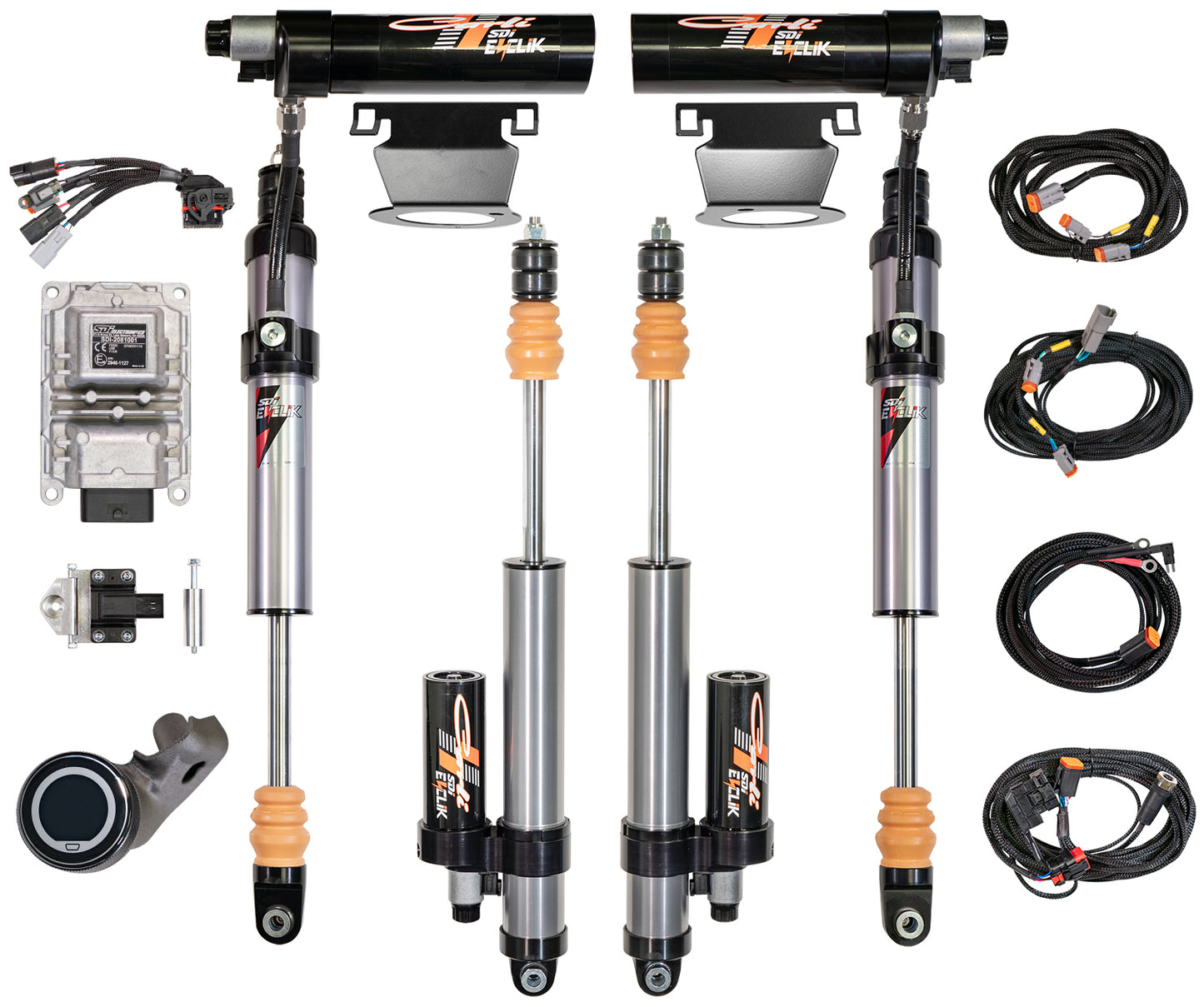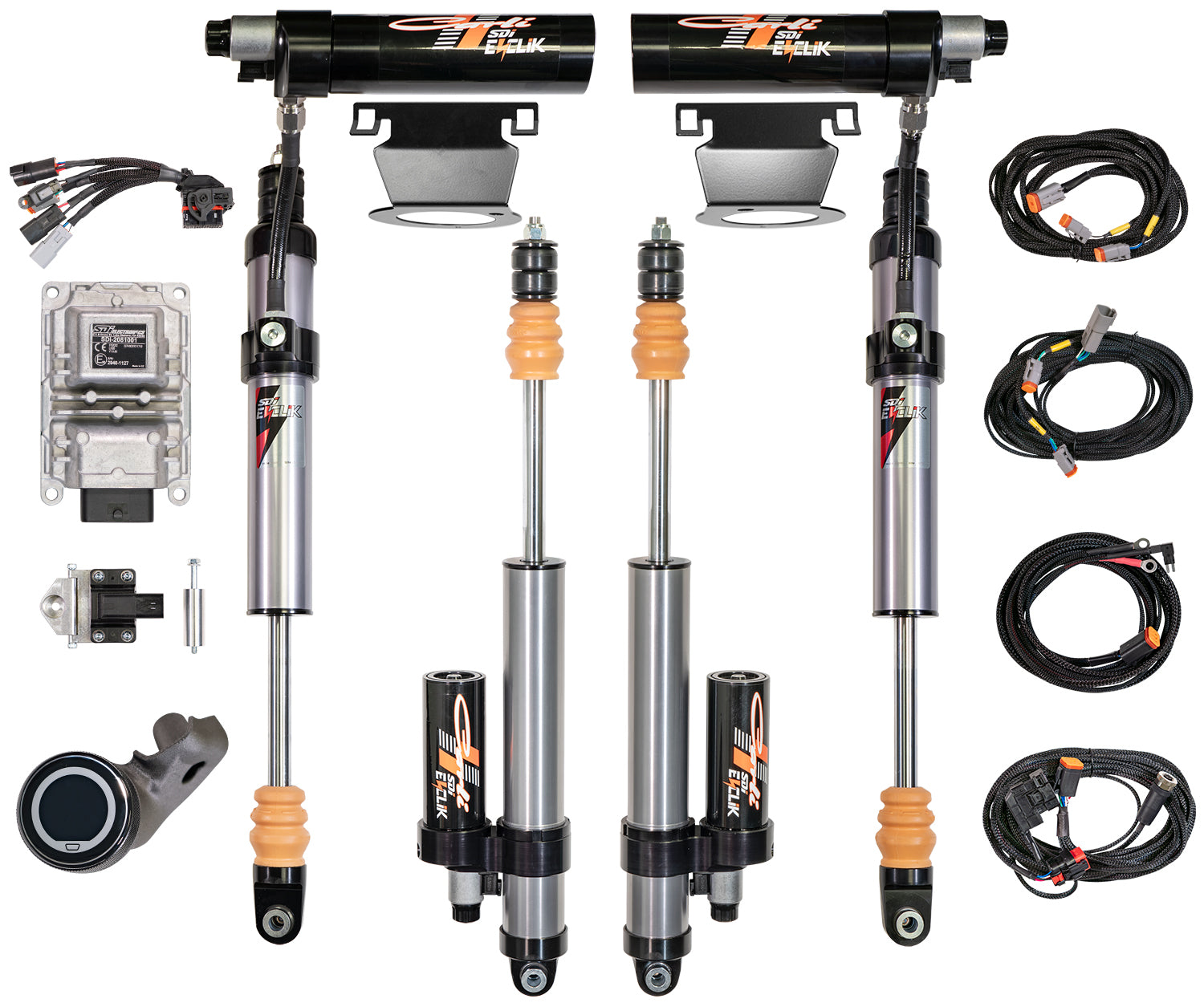Product Description:
NOTE: This shock package is only intended as an upgrade to existing Carli Suspension Lift Systems; we DO NOT recommend pairing this with other lift kits nor will we guarantee compatibility.
- Carli Custom Tuning & Drive Modes
- SDI 2.5", Remote-Reservoir Shocks Front and Rear
- Hard Anodized Aluminum Body/Reservoirs
- 17-4 Stainless Shock Shafts
- Includes Wiring, ECU, IMU & Touch Screen
- Includes Front Reservoir Mounts
- Includes Rear Brake Line Tabs
- Fitment - 2019+ Ram 2500 4x4, Diesel
- Compatible ONLY with Carli 3" Front Springs & 1" Rear Springs
- Not compatible with Auto-Leveling Air Suspension
The future has arrived. The E-Venture system stays two steps ahead of the driver thanks to data input from a provided engine mounted sensor and factory sensors via the OBDII port. The in-cab mounted “Brain” of this system processes the information through a proprietary algorithm. Thanks to this cornucopia of electronic goodness, the E-Venture System reads and reacts the terrain 250 times per second. The resulting ride is the Best. The “best” is an absolute statement… On road? Off Road? Gravel? Rutted, pot-hole filled unmaintained lease roads? Yes… Yes to all of it. The systems takes the capability of a 2.5″ Shock well beyond the threshold we’ve come to expect!
Shocks
The shocks themselves are top-tier construction. Hard-anodized aluminum bodies and reservoirs pair with 17-4 Stainless Shock Shafts will stand the test of time and elements. Billet Rod ends house teflon lined bearings to ensure industry leading performance and longevity.
Electronic Control Unit
The “Brain” of the system is the ECU (Electronic Control Unit). The ECU Harness uses a large OEM-style connector with a rocker linkage to ensure it remains secured once fastened. We played with a few mounting locations in our R&D and the heat-cycling of our initial under-hood location proved detrimental to the ECU’s operable temperature range. We redesigned the harness to accommodate an in-cab mounting location (under the driver’s seat) and have had no overheating activity since.
Harnesses
The ECU Harness is home to the connectors for the 4 harnesses in the system that allow all transmission of power and data. All connectors are unique to ensure connections to the ECU can’t be mixed up.
Front Shock Harness: Male Connection on the harness, Female on ECU Harness. Connects 2 Front Shocks to the ECU.
Rear Shock Harness: Female Connection on harness, Male on ECU Harness. Connects 2 Rear Shocks to the ECU.
Power Harness: Wires Power and Ground for the system and includes a fuse Tap to indicate ignition power to the system.
Communication Harness: OBDII, Touch Screen, and IMU Sensor Connections all feed into ECU.
Sensors
Via the communication harness, the ECU accesses data from the engine mounted IMU (Inertial Measurement Unit). This unit senses any change in pitch/roll of the vehicle. The data from this IMU combines with information gathered from the OBDII port (Brake Pressure, RPM, Steering Angle, Throttle, etc.) to anticipate changes in chassis movement. Subsequently, it firms and softens the shocks where necessary to maintain a chassis that’s as level as possible.
Touch Screen
The most important part of the interface is the one with which you interact. SDI put in a TON of work here to ensure a user-friendly interface with clean integration. We worked with them to take it a step further. The Bracket and Touch Screen mount in place of the bottom grab-handle bolt cover placing the touch screen both visible and out of the way. We provide a longer bolt to secure the screen. This location allows for clean routing of the wiring harness that feeds the Touch Screen without the need to trim the grab handle or weather-stripping.
Carli Modes
We worked with SDI to refine the drive modes; we wanted to increase the seat-of-the pants change between each mode. Offered on the E-Venture System are Mountain (Rock-Crawl), Street and Desert Modes. This is in order from softest/least sensitive to most controlled/active. These modes have been EXTENSIVELY refined; there’s nothing standard about them. All you, as the customer, need to do is select the mode and the system will activate the profile instantaneously.
Within each of the above modes, users can refine the ride to their taste and it will auto-save the profile. There are adjustments for the front and rear shocks independently to increase control or comfort within each of the drive modes. We tuned and refined our recommended settings to be centered on ALL drive modes but that doesn’t mean you won’t prefer to run the front in the center of the adjustment and rear all the way toward comfort. Point is, it’s completely up to you!


